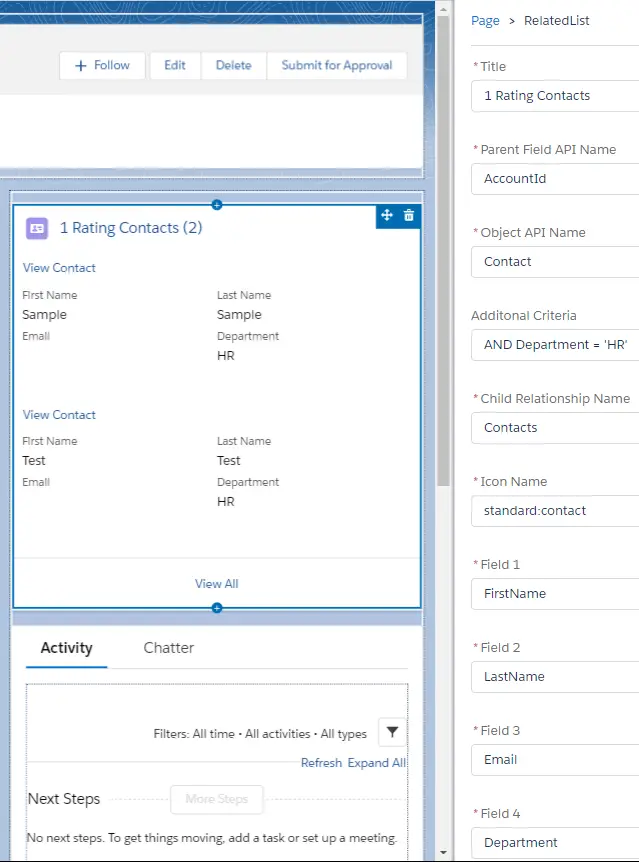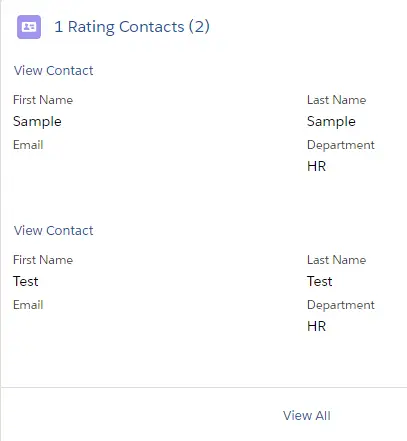Sample Code:
Apex Class:
Apex Class:
- public class RelatedListController {
- @AuraEnabled
- public static RelatedListResult fetchRecs( String recId, String sObjName, String parentFldNam, String strCriteria ) {
- String strTitle = ‘ (‘;
- List < sObject > listsObjects = new List < sObject >();
- RelatedListResult obj = new RelatedListResult();
- String strSOQL = ‘SELECT Id FROM ‘ + sObjName + ‘ WHERE ‘ + parentFldNam + ‘ = ” + recid + ”’;
- if ( String.isNotBlank( strCriteria ) )
- strSOQL += ‘ ‘ + strCriteria;
- strSOQL += ‘ LIMIT 4’;
- listsObjects = Database.query( strSOQL );
- Integer intCount = listsObjects.size();
- if ( intCount > 3 ) {
- List < sObject > tempListsObjects = new List < sObject >();
- for ( Integer i = 0; i <3; i++ )
- tempListsObjects.add( listsObjects.get( i ) );
- obj.listsObject = tempListsObjects;
- strTitle += ‘3+’;
- } else {
- obj.listsObject = listsObjects;
- strTitle += String.valueOf( intCount );
- }
- strTitle += ‘)’;
- obj.strTitle = strTitle;
- return obj;
- }
- public class RelatedListResult {
- @AuraEnabled
- public String strTitle;
- @AuraEnabled
- public List < sObject > listsObject;
- }
- }
Lightning Component:
- <aura:component implements=“flexipage:availableForRecordHome,force:hasRecordId” access=“global” controller=“RelatedListController” >
- <aura:attribute name=“relatedListURL” type=“String”/>
- <aura:attribute name=“title” type=“String”/>
- <aura:attribute name=“criteria” type=“String”/>
- <aura:attribute name=“parentFieldName” type=“String”/>
- <aura:attribute name=“sobjectName” type=“String”/>
- <aura:attribute name=“ObjectName” type=“String”/>
- <aura:attribute name=“childRelName” type=“String”/>
- <aura:attribute name=“iconName” type=“String”/>
- <aura:attribute name=“field1” type=“String”/>
- <aura:attribute name=“field2” type=“String”/>
- <aura:attribute name=“field3” type=“String”/>
- <aura:attribute name=“field4” type=“String”/>
- <aura:attribute name=“listRecords” type=“sObject[]”/>
- <aura:handler name=“init” value=“{!this}” action=“{!c.fetchRecords}”/>
- <lightning:card iconName=“{!v.iconName}”>
- <aura:set attribute=“title”>
- <aura:if isTrue=“{!not(empty(v.listRecords))}”>
- <lightning:button variant=“base”
- label=“{!v.title}”
- title=“View All Action”
- onclick=“{! c.viewRelatedList }”/>
- </aura:if>
- </aura:set>
- <p class=“slds-p-horizontal_small”>
- <aura:iteration items=“{!v.listRecords}” var=“item”>
- <lightning:button variant=“base”
- label=“{! ‘View ‘ + v.ObjectName }”
- title=“View”
- onclick=“{! c.viewRecord }”
- value=“{!item.Id}”/>
- <lightning:recordViewForm recordId=“{!item.Id}” objectApiName=“{!v.sobjectName}”>
- <div class=“slds-grid”>
- <div class=“slds-col slds-size_1-of-2”>
- <lightning:outputField fieldName=“{!v.field1}” />
- </div>
- <div class=“slds-col slds-size_1-of-2”>
- <lightning:outputField fieldName=“{!v.field2}” />
- </div>
- </div>
- <div class=“slds-grid”>
- <div class=“slds-col slds-size_1-of-2”>
- <lightning:outputField fieldName=“{!v.field3}” />
- </div>
- <div class=“slds-col slds-size_1-of-2”>
- <lightning:outputField fieldName=“{!v.field4}” />
- </div>
- </div>
- </lightning:recordViewForm><br/><br/>
- </aura:iteration>
- </p>
- <aura:set attribute=“footer”>
- <aura:if isTrue=“{!not(empty(v.listRecords))}”>
- <lightning:button variant=“base”
- label=“View All”
- title=“View All Action”
- onclick=“{! c.viewRelatedList }”/>
- </aura:if>
- </aura:set>
- </lightning:card>
- </aura:component>
Lightning Component Controller:
- ({
- fetchRecords : function(component, event, helper) {
- var temObjName = component.get( “v.sobjectName” );
- component.set( “v.ObjectName”, temObjName.replace( “__c”, “” ).replace( “_”, ” “ ) );
- var action = component.get( “c.fetchRecs” );
- action.setParams({
- recId: component.get( “v.recordId” ),
- sObjName: temObjName,
- parentFldNam: component.get( “v.parentFieldName” ),
- strCriteria: component.get( “v.criteria” )
- });
- action.setCallback(this, function(response) {
- var state = response.getState();
- if ( state === “SUCCESS” ) {
- var tempTitle = component.get( “v.title” );
- component.set( “v.listRecords”, response.getReturnValue().listsObject );
- component.set( “v.title”, tempTitle + response.getReturnValue().strTitle );
- }
- });
- $A.enqueueAction(action);
- },
- viewRelatedList: function (component, event, helper) {
- var navEvt = $A.get(“e.force:navigateToRelatedList”);
- navEvt.setParams({
- “relatedListId”: component.get( “v.childRelName” ),
- “parentRecordId”: component.get( “v.recordId” )
- });
- navEvt.fire();
- },
- viewRecord: function (component, event, helper) {
- var navEvt = $A.get(“e.force:navigateToSObject”);
- var recId = event.getSource().get( “v.value” )
- navEvt.setParams({
- “recordId”: recId
- });
- navEvt.fire();
- }
- })
Lightning Component Design:
- <design:component>
- <design:attribute name=“title” label=“Title” required=“true”/>
- <design:attribute name=“parentFieldName” label=“Parent Field API Name” required=“true”/>
- <design:attribute name=“sobjectName” label=“Object API Name” required=“true”/>
- <design:attribute name=“criteria” label=“Additonal Criteria”/>
- <design:attribute name=“childRelName” label=“Child Relationship Name” required=“true”/>
- <design:attribute name=“iconName” label=“Icon Name” required=“true”/>
- <design:attribute name=“field1” label=“Field 1” required=“true”/>
- <design:attribute name=“field2” label=“Field 2” required=“true”/>
- <design:attribute name=“field3” label=“Field 3” required=“true”/>
- <design:attribute name=“field4” label=“Field 4” required=“true”/>
- </design:component>
App Builder configuration:
Output:

